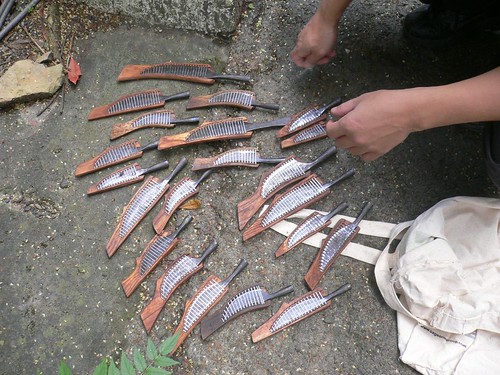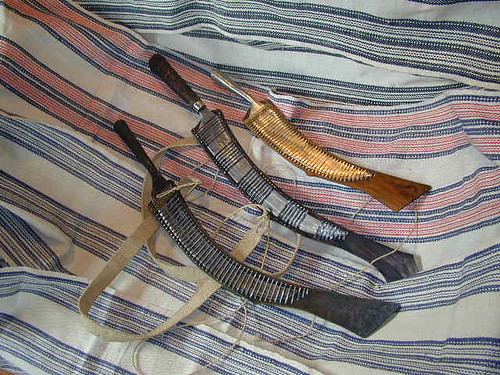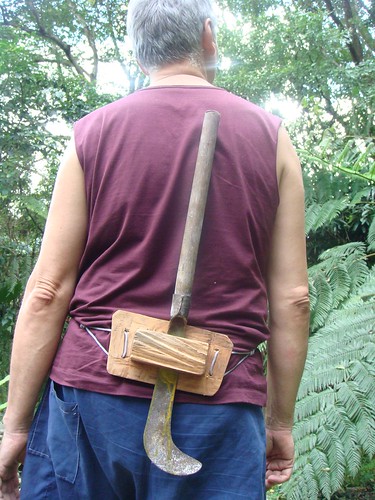
 |
|
|
#31 |
|
(deceased)
Join Date: Dec 2004
Location: East Coast USA
Posts: 3,191
|
[QUOTE=KuKulzA28]Is this one Taiwanese Aboriginal? Tribal Burmese? It's advertised as African...
 TOURIST STUFF 
|
|
|

|
|
|
#32 |
|
(deceased)
Join Date: Dec 2004
Location: East Coast USA
Posts: 3,191
|
Here is a pic I found notice the knife on the the gentlemens belt.
Lew |
|
|

|
|
|
#33 |
|
Member
Join Date: Dec 2004
Location: What is still UK
Posts: 5,924
|
Very cool Lew as is your new avitar. Is it your belt mask? Can you provide any information about this picture. The gentlemans knife does look very similar. There is some differences concerning the scabbard but that would not be unusual. A Philippine Island link is mentioned here?
http://www.vikingsword.com/vb/showth...438&page=2&pp= |
|
|

|
|
|
#34 |
|
(deceased)
Join Date: Dec 2004
Location: East Coast USA
Posts: 3,191
|
Hi Tim
Yes it is my belt mask  sorry but I plucked that pic a couple of years ago from ebay I do not have any info on it sorry but I plucked that pic a couple of years ago from ebay I do not have any info on it  Lew |
|
|

|
|
|
#35 |
|
Member
Join Date: Dec 2004
Posts: 951
|
Hi Tim here are some pics .
From 1912 Philipine Ben |
|
|

|
|
|
#36 |
|
Member
Join Date: Dec 2004
Location: What is still UK
Posts: 5,924
|
Very kind of you Ben but none of the last few post are as convincing as this page of a members rather super web site.
http://www.formosatribal.com/show.php?item_id=69 |
|
|

|
|
|
#37 | |
|
Member
Join Date: Dec 2004
Posts: 951
|
Quote:
Hi Tim looks a lot the same Ben Last edited by Dajak; 28th December 2008 at 04:53 PM. |
|
|
|

|
|
|
#38 |
|
Member
Join Date: Dec 2004
Location: What is still UK
Posts: 5,924
|
This one also, with the same staining to the blade and lack of rattan to the handle.
http://www.formosatribal.com/show.php?item_id=67 |
|
|

|
|
|
#39 |
|
Member
Join Date: Oct 2008
Location: between work and sleep
Posts: 731
|
 Can you guys tell if this is authentic? The sheath makes me think Paiwan maybe... to my untrained eyes it seems very similar to these Paiwanese sword examples....   however it lacks that large rectangular piece... not sure, it's perhaps a nice looking but old and broken tourist piece, or an actual Aboriginal blade... 
|
|
|

|
|
|
#40 |
|
Member
Join Date: Dec 2004
Location: What is still UK
Posts: 5,924
|
There is something lacking in the figure carving which makes me thick you have a tourist piece. I have a similar straight blade like that with a plain scabbard, foreign stamped on the blade. Interestingly the blade is good quality well made and sharp. I cannot show it as it lives in the roof space with a few other errors in judgement.
|
|
|

|
|
|
#41 |
|
Member
Join Date: Oct 2008
Location: between work and sleep
Posts: 731
|
mmm, you're right about the carving, it does lack a bit in finesse, or at least not the same as you see in Paiwan sheaths usually... perhaps others will speak up about this... but thanks for your help, I agree, it's probably touristy

|
|
|

|
|
|
#42 |
|
Vikingsword Staff
Join Date: Nov 2004
Posts: 6,376
|
Is the blade laminated on a core ?
This is older work tourist or not and as such still has value . I don't think their equal is being produced today . Our man on the scene would know more about that aspect . 
|
|
|

|
|
|
#43 |
|
Member
Join Date: Sep 2005
Location: Ex-Taipei, Taiwan, now in Shanghai, China
Posts: 180
|
Hello everybody,
First, I want to thank Tim for mentioning in his posts the link to my collection website (www.formosatribal.com). Shouldn't there be a picture on the post 28, from Ben ? Tim and Ben are discussing about a sword that I canít see anywhere in the thread. Did I miss something ? Lew, your picture is definitely one of Taiwanese aboriginals from the Atayal tribe, in the northern part of the island. Their knives are very similar to the one I display on my website (see the link mentioned by Tim). Youíll have to wait longer to see detailed pictures of Atayal straight blades as Iím away from home for 3 more weeks. Kukulza 28, the first two knives you have shown in your posts are Taiwanese, yes, but they were commercially made in the 50s/60s to be sold to the American troops stationed in the island. The motives are inspired from the Paiwan but are mixed with an international fusion tribal style. The third knife you displayed is mine and was exhibited last year at the Shisanhang Prehistory Museum, in the Taipei District (www.sshm.tpc.gov.tw). For the aficionados of Taiwanese tribal/aboriginal art, 4 Paiwan knives (lot 2 and 3) reached a high price at the Sothebys tribal art auction sales of last December. The knives were sold for an average price of more than 5000 euros each. Yuanzhumin/Nicolas |
|
|

|
|
|
#44 |
|
Member
Join Date: Oct 2008
Location: between work and sleep
Posts: 731
|
so YOU'RE the guy behind the Yang-Grevot collection?!
I've been pouring over those pictures for a long time... those are some great examples of Aboriginal objects!  I'm Taiwanese American and until I did some research... I didn't even know about the Wushe Rebellion, or the 228 Massacre, or the history of Dutch and Chinese colonization, Koxinga, and the Aborigines throughout it all... it was so enlightening for me to realize that the Kuo Ming Tang flag was one of massacre, assimilation, and oppressive regime... not exactly the crusade against communism that I had been led to believe. I didn't know that I may very well be part aborigine like many Hoklos. I'm now very interested in my heritage, historically, culturally... and of course in the martial arts and weaponry area as well. 
|
|
|

|
|
|
#45 |
|
Member
Join Date: Dec 2004
Location: What is still UK
Posts: 5,924
|
Yuanzhumin, there was slight confusion over this knife which we have discussed before.
|
|
|

|
|
|
#46 |
|
Member
Join Date: Dec 2004
Location: What is still UK
Posts: 5,924
|
Any pictures of those knives that went for such high prices.
|
|
|

|
|
|
#47 | |
|
Member
Join Date: Jul 2006
Location: Berlin-Paris
Posts: 37
|
Quote:
|
|
|
|

|
|
|
#48 |
|
Member
Join Date: Dec 2004
Location: What is still UK
Posts: 5,924
|
Thank you, I take it these are the 5000 euros examples. They are nice, I would say they are museum quality but that does not means they are 5000 euros worth. To me museum quality is not about money value.
|
|
|

|
|
|
#49 |
|
Member
Join Date: Jul 2006
Location: Berlin-Paris
Posts: 37
|
I don't think you should take these as a price example; they were largely overpaid as I explain the context of the auction. Museum quality might not even be that price specially for first half of the XXth century knives. Fortunately!
|
|
|

|
|
|
#50 |
|
Member
Join Date: Oct 2008
Location: between work and sleep
Posts: 731
|
|
|
|

|
|
|
#51 |
|
Member
Join Date: Oct 2008
Location: between work and sleep
Posts: 731
|
I know this forum is not as interested in contemporary ethnographic weaponry in comparison to antiques... but I found a vendor of many of the Copper-Gate village Fan Dao or Shan Dao (I've heard them called either one byt my relatives). The Hualien Taroko knife-makers, especially in Copper-Gate all seem to be relatives. I'm currently in Taiwan right now visiting family, but I'll be sure to stop by Hualien to satiate ethnographic/heritage weaponry interests.
I'm sure Yuanzhumin could tell you more about these. He's native and I'm American-born. He's a specialist, and I'm an aficionado. Plus I'm illiterate in Mandarin and can barely speak Taiwanese. But for anyone who's interested, here's some websites: >> http://www.001.com.tw/yahoo/TM-knife/yahoo.htm << http://www.001.com.tw/house/stoneland-house/2-2.htm http://blog.taroko.gov.tw/myblog/jjy...RpdHlJRD0xMjY= http://tw.myblog.yahoo.com/yan9436/a...v=751&next=640 http://www.libertytimes.com.tw/2008/...day-north1.htm http://tw.myblog.yahoo.com/jw!k87nOF.TREbqgMV2roAH/article?mid=3273 http://www.kpps.tyc.edu.tw/worker1/worker.htm http://tour-hualien.hl.gov.tw/index....18&SceneId=467 http://librarywork.taiwanschoolnet.o...travel/t04.htm http://www.ogsppg.com.tw/tour_data.asp?hidID=1977 |
|
|

|
|
|
#52 |
|
EAAF Staff
Join Date: Nov 2004
Location: Upstate New York, USA
Posts: 968
|
I am much chagrined to admit that I have missed this entire thread previously. Thanks Ian for posting my knife and thanks Yuanzhumin for identifying its origin. And thanks Tim for pointing out the fine Formosa Tribal website to which I have also taken the liberty of posting a link from the main EAA page. And thanks Kukukza28 for bringing this thread back up top.
Last edited by Lee; 23rd May 2009 at 11:54 PM. |
|
|

|
|
|
#53 |
|
Member
Join Date: Oct 2008
Location: between work and sleep
Posts: 731
|
I believe this is a modern made Atayal type blade. It was used for fighting (and headhunting), survival out in the wilderness, etc. Itís a good solid blade, legit ferrule/bolster(?), rattan handle, thick spine, gently curved blade, single bevel, open sheath, and has a good feeling. I got it from the Tung-men (Copper-gate) folks at Hua-lien. I also visited the Atayal museum at Wu-lai. It was very interesting. I was a bit surprised to find that many Yuan Zhu Min are pro-KMT as opposed to DPP - somewhat ironic... but let's leave politics aside. I learned quite a bit today. They had a good collection of blades and spears.
 
|
|
|

|
|
|
#54 |
|
Member
Join Date: Oct 2008
Location: between work and sleep
Posts: 731
|
Research Update:
Aside from the Aboriginal smiths at 銅門, Hualien I have also discovered that there are a few others in Taiwan. One is in 新店 (Shing-dian) and another in 桃園 大溪 (DaSi, Tao-yuan).... maybe one in San-xhia. The one is DaSi may be Hakka but seems to have been making Atayal blades for the tribesmen for some time now. Today they use spring steel and nails to make blades and arrowheads (and fishing spears). Seems like there's a very limited amount of hunting still going on... and that the blades are not illegal, but not entirely legal.. obviously if they were illegal, the mainly Chinese 開山刀 users would be screwed. The 開山刀 are usually hook-shaped, like bill-hooks, almost like a S.Indian aruvaal. They are the Chinese version of machetes. Some Japanese soqi are used too. It seems the aboriginal blades are of better quality and preferable for survival, forestry, and mountaineering work. That is not to say all the Chinese hook-machetes are terrible, in fact there are some good quality ones out there. The Atayal's machete-sword is called a laraw (lah-rao, rhymes with cow). Their smaller utility knives are called puli (boo-LEE). Hualian's smiths apparently make blades for all the tribes and tourists as well, but the blade-makers I found out about above seem to only make for Atayal. I'll see if I can gather more information on other groups' blades. I know these aren't antiques that I am digging up, but the state of today's aboriginal cultures of Taiwan and their handicrafts, including weaponry, still lives on, though barely in some cases. However, there are still some quality blades being made and used, though not for headhunting. There doesn't seem to be much interest but I'll keep posting up my research for those who are. 
|
|
|

|
|
|
#55 |
|
Member
Join Date: Jul 2005
Location: Toronto, Canada
Posts: 1,242
|
Thanks for great info Kukulza. Rest assured there is interest in this culture and its blades. I just think few of us are in the position to add anything meaningful.
Emanuel |
|
|

|
|
|
#56 |
|
Member
Join Date: Dec 2004
Location: What is still UK
Posts: 5,924
|
Yes great interest. I might add that Nicolas is now the owner of the example I had.
|
|
|

|
|
|
#57 | ||
|
Member
Join Date: Oct 2008
Location: between work and sleep
Posts: 731
|
Quote:
Quote:
Lucky Nicholas, authentic Taiwanese aboriginal pieces are rare, I hope he treasures it forever... if not he should hit me up with a message  hahaha, but I have no doubt he will hahaha, but I have no doubt he will
Last edited by KuKulzA28; 10th August 2009 at 10:57 PM. |
||
|
|

|
|
|
#58 |
|
Member
Join Date: Oct 2008
Location: between work and sleep
Posts: 731
|
More on modern-made Taiwanese Aborigine (原住民) blades... I am surprised at how helpful some folks are... when the person contacting them in far away and may never meet them face to face. I am trying to figure out the general location of the few aboriginal or sino-aboriginal blade-makers left.... so far I am having more success with the Atayal, perhaps because I am more interested in their blades or perhaps because their blade making and usage is more intact... not sure.
If Yuanzhumin (anglicized for 原住民) was around more I'm sure he'd be way more helpful! EDIT: Yuanzhumin if you're reading this stuff, please feel free to chime in. I take no credit for these photos, they belong to their owners, posted on flickr Yugan Dali's photos on flickr. These are puli (bulee) and laraw (la-row).   fm4715/魯獅's photo on flickr. I do not recognize who makes these Laraw.  Kimisibal's photo on flickr... looks to be from Hualien but I am not sure. 
Last edited by KuKulzA28; 4th September 2009 at 01:02 AM. |
|
|

|
|
|
#59 |
|
Member
Join Date: Oct 2008
Location: between work and sleep
Posts: 731
|
In addition to those above, I am trying to trace the origins of these, which may be tourist blades
 : :  These seem to be the 銅門, Hualien made Aboriginal blades mixed with some sickle-like 開山刀 in the mix. It would seem the Aboriginal blades give a good account of themselves as "machetes". I myself have tested mine out - not bad! Most Han Taiwanese use 開山刀 for brush clearing like a machete. It is also commonly used in Guangdong and Fujian where the handcrafts of making such tools is also dying... ironically while the villagers in both areas prefer the well-made, quality tools of old master craftsmen... very few young apprentices are to be found.  On the side... Yugan Dali's photo on flickr showing one way to wear a sickle-開山刀 
Last edited by KuKulzA28; 4th September 2009 at 04:02 AM. |
|
|

|
|
|
#60 |
|
Member
Join Date: Oct 2008
Location: between work and sleep
Posts: 731
|
For those interested...
this Taiwanese aboriginal blade looks like a single butterfly sword's blade with a typical aboriginal metal socket handle. It is sheathed in the Aboriginal way. I want to say it is from one of the western plains groups, and had a lot of Chinese influence... but I am no expert.  One of freebooter's butterfly swords for reference: [from freebooter's Swords & Antiques Gallery]  
Last edited by KuKulzA28; 4th January 2010 at 09:37 PM. |
|
|

|
 |
|
|